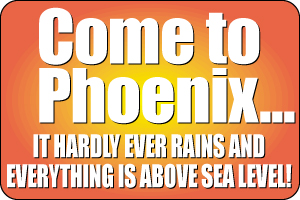Holy smokes!
The Phoenix region has landed on a list of “extremely” overvalued housing markets
But, but but! Of course there’s a “but”:
but it’s unlikely that the situation will lead to meaningful drops in home prices, several local housing analysts said.
Whew! That was a close one!
Well, not really. The cited text comes from the Arizona Republic, reporting alarmist predictions that are based on no actual, on-the-ground experience that I can detect. The ‘researchers,’ “Global Insight and National City Corp., a Cleveland-based mortgage lender,” couch everything they dare to say in the most mealy-mouthed possible language, for that simple reason that any long-range prediction about a particular real estate market is inherently suspect. Our Cleveland mortgage lenders only dare to make mealy-mouth predictions for–wait for it–“299 metro areas.”
When did reporters forget how to make the Bronx Cheer? Isn’t that what Hildy Johnson used to do, in The Front Page, when fed a line of bull?
Here’s a better question. Assuming the absolute mealy-mouthed worst for the Phoenix market, how bad will things get?
“[W]hen you look back at markets that have declined 10 percent or more over two years, those markets were overvalued by that much or more[.]”
That’s choice. What it almost says is that the Valley might be at risk of losing 10% of the current market value of homes over the next two years. That is to say, the house that was worth $145,000 in December of 2003, which is now worth $265,000, may only be worth $238,500 in December of 2007. I’ll take bets against that outcome at $100 a head, down to my last dollar. But, even conceding the (unmade) point, the four-year appreciation on the home would be 64%, $93,500 in unearned increment–wealth accrued without having to be produced.
But what the quotation actually says is this: If it turns out that homes have lost 10% of their value over two years, it’s because they had been overvalued by 10% or more. Translated into English, it’s just stupid. It sounds tautological, but it isn’t, actually, because it introduces a false idea of causation.
The value of a thing is what that thing will Read more


